Hyundai Ioniq 6 LR AWD review
The Hyundai Ioniq family has been growing, and we are already looking at the Ioniq 6. It is an all-electric sedan - the first non-SUV based on the E-GMP platform used by Hyundai and Kia.

Although they share the same platform, the Ioniq 5 and 6 follow completely different design concepts. The Ioniq 5 is an angular SUV with big space and chunky styling, while the Ioniq 6 goes all-out on optimizing drag with smooth lines, fine curves and elongated body.

The Hyundai Ioniq 6 is really competitively priced. In most parts of the world, its low price, striking looks and solid build should win over the competition and make it a staple of Hyundai's lineup.

We had our hands on the most powerful version yet - 77.4 kWh LR AWD, finished in the amazing "Byte Blue Solid" color, which commands no extra fee. It was also equipped with the smaller 18-inch tires that offer better range and improved driving comfort.
Hyundai Ioniq 6 LR AWD at a glance:
- Dimensions: 191.1 inches x 74 inches x 58.9 inches, 116.1 inches wheelbase.
- Drivetrain tested: Long Range AWD - AWD 239 kW (325 hp), 446 lb-ft, 77.4 kWh battery; 75 kWh usable.
- Other drivetrains: SR RWD - RWD, 111 kW (151 hp), 258 lb-ft, 53 kWh total battery capacity.
- Charging: 235 kW DC max, 10-80% in 18 min; 230V electrical outlet (3.6 KW max)
- Range: 362 miles WLTP (316 miles EPA)
- Weight: 4,621 lb unladen
- Other features: Sunroof, 800V architecture, OTA updates, Vehicle to load (V2L), Quiet mode.
Exterior
The Ioniq 6 looks extremely futuristic, and its streamlined body shape makes for a sleek overall design. The raindrop shape aims to maximize efficiency, while the accents throughout the body should make the Ioniq 6 look distinctive. The end result is a polarizing design that is adored by some as looking far more premium than its price suggests and knocked by others for being a Porsche rip-off. Ultimately, from the maker's perspective this is a good thing, as the car sparks discussions and gets more coverage.

The front is a mixed batch of old Hyundai design cues and modern touches. The general shape with the long and narrow headlights, flat hood and thin grille covering the whole lower bumper, is highly reminiscent of the Hyundai Coupe from the mid 2000's. Of course, all details are modernized, and the headlights are fully LED.

The grille is not present at all times and opens only when needed, but remains closed most of the time to improve aerodynamics. The grille's lowest center point is occupied by six LED squares, which light up when the Ioniq is charging. The theme of the pixelated squares repeats a lot throughout the vehicle and has become a hallmark of the Ioniq 5 and 6 models.

Moving to the side profile, the shape of the Ioniq 6 makes it clear that the main focus of the vehicle is to optimize efficiency, and form follows function. The elongated lines make it appear longer than it is. All lines combine at the back towards the taillights to finish the raindrop look.



The side profile of the Ioniq 6 is stately and shows unique features for the model.
The flushed doors aim to help reduce the drag coefficient ever so slightly while also improving the looks of the car. When you approach the Ioniq 6 with the key in your pocket, the handles pop out for ease of access.
However, this function failed multiple times during our review, and the handles either refused to pop open or failed to close when locking the car, which makes the feature more annoying than useful.

The small 18-inch tires don't look great compared to the optional 20-inch ones, but where they shine is comfort and range. You should carefully consider whether looks or practicality is what you're looking for when configuring this car and which trait you're more willing to sacrifice. The tires on our car were Hankook Ventus s1 evo 3, which proved to be efficient tire, that still offers a lot of grip, but also caused a lot of tire noise inside the cabin.

Our vehicle came with regular mirrors, but the optional camera mirrors truly make a statement from the outside and attract many onlookers. They also improve the total drag for a few extra kilometers of range. As a driver, adjusting to the digital mirrors inside the vehicle takes a lot of time, but eventually, everything is fine. This function is more of a gimmick than a necessity, and that is why we recommend you opt for traditional mirrors when speccing the car.



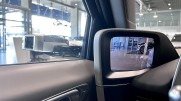
Regular mirrors pale in comparison with the optional digital ones, which look truly futuristic.
The rear of the Ioniq 6 really stands out. The dual ducktail spoilers look like they belong to a track car, but instead, they are on a regular midsize sedan. Of course, they also serve the purpose to reduce drag, but also make the rear of the Ioniq 6 look like nothing else on the market in that segment.

Another distinctive feature around the back is the huge LED bar that incorporates the tail and brake lights and spans from side to side. Inside, it comprises pixelated squares that light up to make for a unique light signature.

The rear-view camera and the trunk popper button are also squares and are placed on the lower spoiler, right below the Hyundai logo. They look like an afterthought and disturb the overall sleek design of the back of the Ioniq 6. Also, putting the opening button away from the trunk lid makes opening it a two-step process, which is not a convenient solution.

The rear bumper is finished in black and incorporates vertically mounted reflectors and the rear lights, which are once again pixelated. It completes the design of the Ioniq 6 and gives it a sporty look.

Possibly the strangest feature of the Ioniq 6 is the see-through antenna, which lets you see inside its mechanism. Sports car manufacturers let their customers have clear engine bays to see the engine, while Hyundai has decided to offer a see-through shark fin antenna for whatever reason. That is a bizarre quirk but a nice conversation starter.
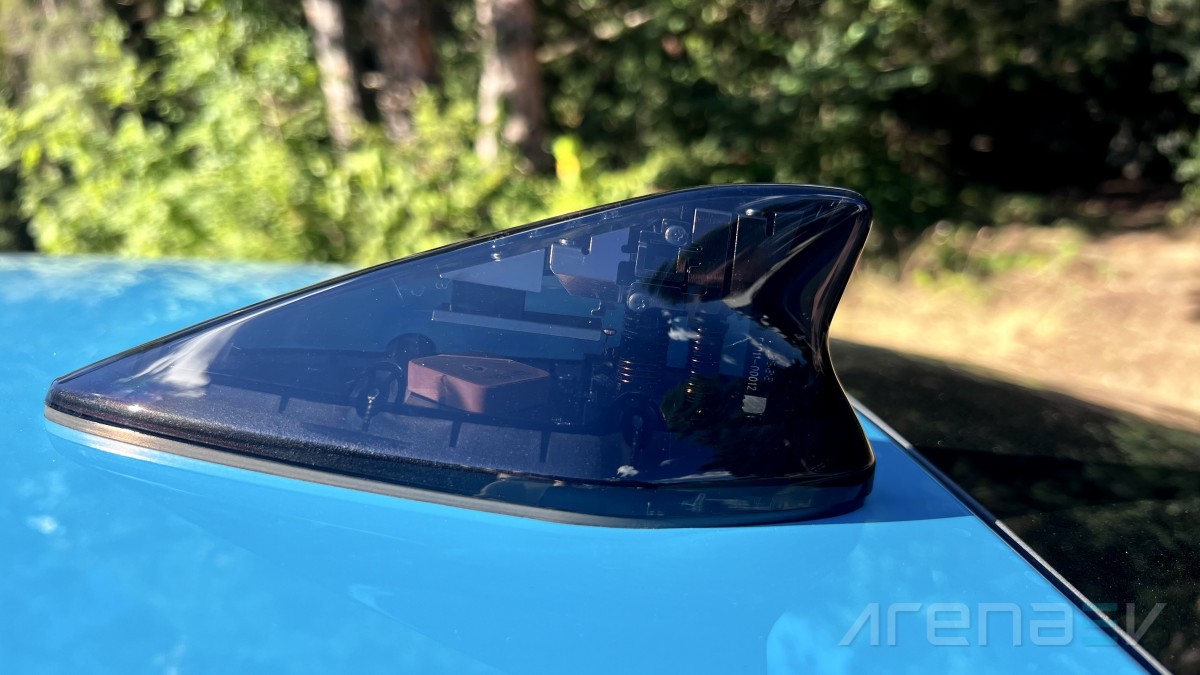
Many people have criticized the design of the Ioniq 6 for looking too much like a Porsche, and there are striking similarities, especially around the rear three quarters. However, when you take a closer look at the Hyundai, it is evident that it's not a mere copycat, but an independent model with its own styling.

The Ioniq 6 starter key looks like some of the keys back in early 2000's. The gray case with green buttons makes it look extremely outdated, but the way it works is great. The buttons are placed in the Hyundai emblem's blank spaces, while the side of the key is used for remote-controlling the car.
Yes, that is right, the Ioniq 6 can be controlled from the outside, which in theory can be used to get the car out of tight parking spaces. In practice it will most definitely be primarily used for owners to show off in front of their friends.

Interior
Inside the Ioniq 6, its occupants are greeted with premium-feeling, eco-friendly materials and massive displays for the infotainment and gauge cluster.
The interior is modern yet remains traditional and with no radical quirky decisions (except for the optional side mirror displays, which look highly futuristic).
The Ioniq 6 hasn't gone full-touchscreen, and some physical buttons are still left to control the most frequently used features.

The choice of materials is not optimal, and we are not sure how the eco-friendly recycled surfaces will stand the test of time, but on our new car, they are all right.
The surfaces around the doors and the center console are not great to the touch but are fitting for a car that undercuts its competitors in price. Although the materials don't feel premium at all, they seem sturdy enough and the whole thing is well solidly built.

The steering wheel has a flat bottom, which, unusually, doesn't have the Hyundai logo in the middle. Instead, it has four pixelated dots, which light up depending on the mode you're in.
The buttons on the steering wheel are big and easy to use, and their quality feels great to the touch. There is also a round button on the left inner side of the steering wheel, which controls the drive modes, just as in a sports cars from the likes of Porsche or Mercedes. Tall people might find it irritating that the wheel doesn't go toward the driver much, which makes for a weird driving position.

Behind the steering wheel are the regular lights and window washer controls, which are made of solid materials and give a premium feel when used. In the same vicinity is also the gear selector, which operates in a way no other column-mounted shifter works. In just about any other vehicle that has one, to go into D, you push down, and to go into R, you press up. That is not the case in the Ioniq 6, which has them switched around and therefore you need some time to get used to that.

Moving on to the gauge cluster, it is a full display with great visibility but, sadly, isn't too customizable. Although it is 12.3 inches in size, only a small fraction of that can be configured, and no full-screen map or other features can be displayed on it. This makes the head-up display less important, as it doesn't show more or different information than the screen right below it.





The gauge cluster doesn't offer many options for customization, but at least changes its graphics depending on the drive mode.
The center display has the same 12.3-inch diagonal and is a digital touchscreen from edge to edge. It controls most car features, such as the infotainment, navigation and the camera system. It also controls the seat heating and cooling, which is irritating as all other climate control features stay below it on a separate unit.
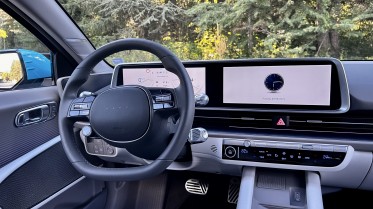

Seat climate controls are operated through the center screen, separate from the A/C controls.
This climate unit is great to use as it has all the settings fixed in place, and the materials of the physical buttons feels very upmarket. The start/stop button is also on this panel to make for a cleaner look of the interior.

The center console is big and incorporates a lot of features. The window switches are right in the middle, as well as the door locks, wireless charger and the cupholders. The USB-A outlet looks like an afterthought as it is not incorporated into the design in any way, nor is it hidden and just sticks out.
The more modern USB-C outlets are hidden in the armrest, where you can also store a lot of items due to the massive size and depth.
Also big is the storage area under the central console, which can easily fit a handbag or some groceries. The door panels, on the other hand, offer almost no storage space.

The sunroof is a nice optional extra, as it can be opened for more fresh air into the cabin. While most EVs offer immovable panoramic sunroofs, Hyundai has decided to grace the Ioniq 6 with a traditional single sunroof that can be fully opened. Using it may decrease the range, but in the right weather, the experience is definitely worth it.

Moving on to the seats, they are nice and comfortable and have a high seating position. This goes to show that the intended purpose of the vehicle is not sporty driving with hard cornering but rather cruising down the highway in a relaxing manner. Our test vehicle had a white interior, which looks amazing but naturally gets dirty easily and requires more care than the standard black one.


The seats are electric and can be adjusted for great comfort.
The second row of seats offers a lot of room but almost no amenities. The legroom that the backseat passengers have is very generous, thanks to the long body of the Ioniq 6. This reviewer is 195 cm (6'4") tall and has just enough space for his head, but since the batteries under the floor take up a lot of space, this causes his knees to go up, creating an inconvenient seating position, which could prove an issue on longer trips.


Even tall passengers fit without problems into the backseats of the Ioniq 6.
An amazing feature that used to be present on only high-end luxury models is the control of the front passenger seat from the rear. On the side of the passenger seat, there are controls that let the rear seat passenger have even more space in the back if they need to.

The backseat passengers also get a very tiny second back window a la Rolls-Royce, which makes the rear less claustrophobic.

Strangely enough, the rear doors look almost identical to the front ones, yet they offer more storage space and also integrate the window switches.

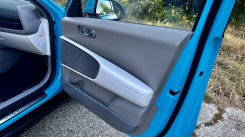

Rear passengers get more door storage, as well as two more USB-C charge ports.
Storage & practicalities
The trunk of the Hyundai Ioniq 6 is rather small for such a massive car and offers just 14.2 ft³ of storage space. Pushing the rear seats down makes transporting longer items easier, but they don't fold flat, which means a lot of space will remain unused. You will find levers in the trunk to operate the folding of the rear seats, which is quite convenient.
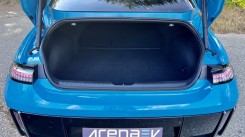


The trunk of the Ioniq 6 is not great in terms of size.
On the right side of the trunk is one of Ioniq 6's most notable features, namely the Vehicle-to-Load (V2L), which allows you to use your car to power your devices. For the outdoorsy types this may be a big reason to choose the Ioniq 6 over its competitors.
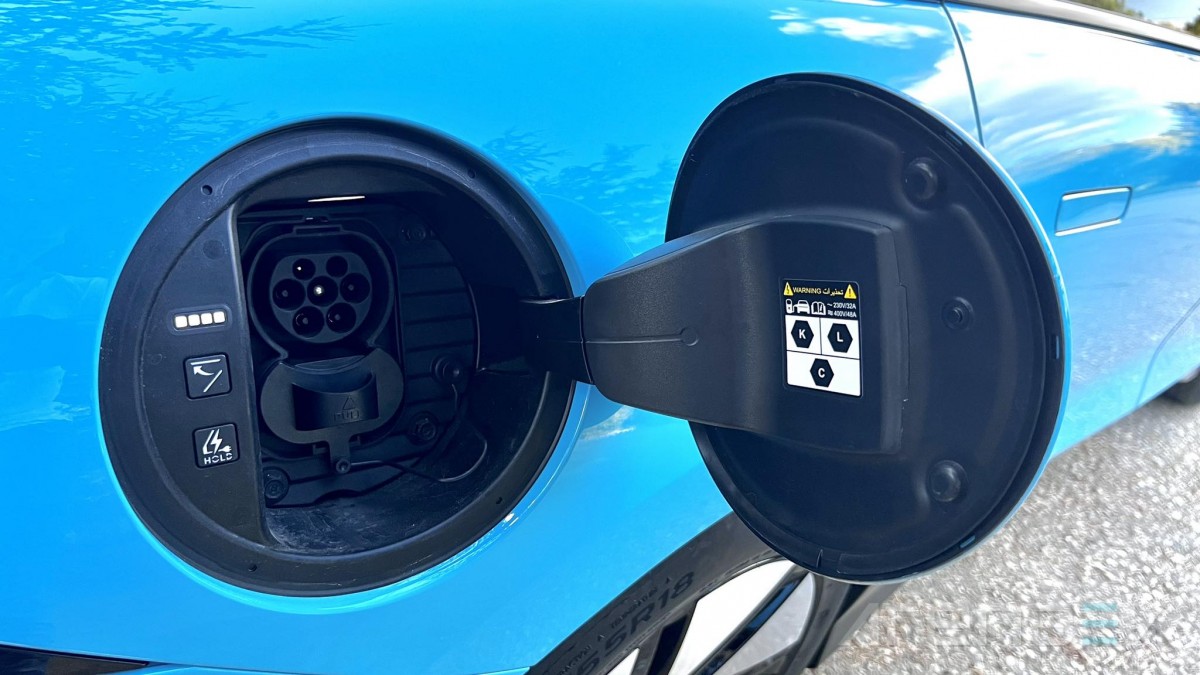
There is also a frunk in the Ioniq 6, but it is so small that it's hardly usable. It provides 0.49 ft³ of storage on our car. The RWD versions offers a 1.59 ft³ frunk, making it a lot more usable but still small compared to Tesla or Ford.

Driving experience
Being behind the wheel of the Ioniq 6 is a rewarding experience as it provides an old-school feel, reminiscent of the American landyachts of the 70's and 80's. The suspension is soft and sleek, and you hardly ever feel the road bumps and potholes.
The steering is very light and feels almost disconnected from the road, which in not the best thing if you like some dynamic driving, but it helps for the smooth ride and great comfort.

The one-pedal driving feature is awesome for city driving and works nice and smooth, easing your driving experience even more.
The turning radius is not great with almost 39 ft and this combines with average handling. The Ioniq 6 is rather disapointing if you fancy a sportier driving style, being clearly focused on comfort and smoothness of the ride.
Tech features
The Ioniq 6 incorporates new technologies greatly into the user experience. As already mentioned, the center touchscreen display controls most features and gives all necessary data about the car. It also offers high-level driver aids to help make your drive that much easier.

When talking about the main control unit, it is important to note just how intuitive and easy to use it is. The default screen is not really useful and shows virtually no important features, but as soon as you start going through the menus, you realize that everything is exactly where you suppose it is. The responsiveness of the touchscreen is good, though not on a smartphone level.
Apple CarPlay and Android Auto work perfectly, and the display can be split into two parts so that you can use all needed features at once. Phone connectivity is easy and works great every time. Sadly, screen mirroring is not wireless, which means you'll have to put your phone in the wired charger at all times. If you don't want to use your phone for navigation, you can surely rely on the built-in sat nav. It can tell you where the nearest charging stations are and plan your trips based on the available chargers en route.



Apple car play works great, while the built-in sat nav is extremely accurate and can show you charging locations.
If you are not a fan of data overload and just want to enjoy a nice and peaceful drive, you can always replace the screen information with a nice digital image of an analog clock. Using quiet mode also creates a peaceful atmosphere if there are people sleeping in the back, as it turns off the rear speakers and plays music only to the front passengers.


The infotainment can make your drive even more quiet and comfortable through different settings.
There are also two blank buttons on the steering wheel and on the center console, which allow you to assign them a custom function. This, for example, can be the voice memo option, which allows you to create voice memos while driving and then later on listen to or export them.



Blank buttons allow you to program what they can do.
When it comes to driver assist technology, Hyundai went quite far. The Ioniq 6 isn't capable of fully autonomous driving and steering, but it can speed up, slow down and keep you in your lane. The camera system for the blind spot turns on when you press the blinkers, which is a really great feature and virtually eliminates the need to peek over your shoulder to check for vehicles.

It can also inform you about the speed limit, which is otherwise a great feature, but the implementation in the Ioniq 6 is quite irritating. It beeps loudly and constantly just to inform you if there is a change in the speed limit. If you go over the speed limit, it also chimes, as well as when you go below the speed limit. Sadly, there is no option to turn it off completely, you can only disable the beeping sound. And even then, it's not permanent, but you have to do it with every start of the vehicle.
The collision or fault warnings are less intrusive and not as loud, so the Speed limit assist irritating way of operation stands out as a bizarre decision by the manufacturer.
Ride comfort
The Ioniq 6 is comfortable vehicle on the road. It can give a lot of high-end vehicles a run for their money when it comes to comfort and insulation from the road. Big potholes and bumps are softened masterfully thanks to the soft suspension. Our bumpy test track wasn't much of a challenge for the Ioniq 6 as it mastered it gracefully.
Cabin noise
The Hyundai Ioniq 6 performs really well in insulating the cabin from the outside world. Though there is some road noise at all speeds and winds become noticeable over 56 mph, the sound levels always remain low, especially for the segment, and the ride remains cozy and pleasant.
Hyundai Ioniq 6 LR AWD Cabin Noise:
| Speed | Cabin Noise |
|---|---|
| 37 mph | 53.8 dB |
| 56 mph | 57.9 dB |
| 81 mph | 62.9 dB |
Sound level tests are carried out with a specialized sound level meter placed in the car’s cupholders. The test is conducted with air conditioning and radio off and while maintaining a steady speed.
Acceleration and braking
The AWD and 325 horsepower give the Ioniq 6 a good push from a dig. The 0 - 62 mph sprint takes exactly 5.0 seconds, 0.1 quicker than what the manufacturer states.
The stopping power of the Ioniq 6 is solid too, and it goes from 62 mph to a halt in 35 m (115 ft), which is a solid number for a car that weighs a little over 2 tonnes.
Consumption
The Ioniq 6 has a streamlined body to optimize its efficiency. The consumption in our tests was impressively low for such a big and heavy vehicle. Our testing was conducted in one of the best possible conditions with an ambient temperature of 75°F.
Hyundai Ioniq 6 Consumption:
| Speed | Consumption | Range |
|---|---|---|
| 37 mph | 5.9 mi/kWh | 440 miles |
| 56 mph | 4.7 mi/kWh | 350 miles |
| 81 mph | 2.8 mi/kWh | 209 miles |
We measure consumption by driving at constant speeds on an identical test route during the day. Testing is conducted with air conditioning, all safety systems and radio on. The data comes from the vehicle's board computer. Specific testing parameters, such as ambient temperature, are mentioned in the text on a case-by-case basis.
Charging speed
The Ioniq 6 is based on an 800V architecture, available as standard, which is a big bonus for the segment, especially for a cheaper vehicle. This allows for very fast charging of merely 18 minutes from 10 to 80% on an ultra-fast 350 kW charger.
The peak charging power we reached was 235 kW, which aligns with what the manufacturer promises.
Competition
The Hyundai Ioniq 6 is in the segment of midsize sedans, which has been significantly shrinking in recent years, yet this body shape allows for the best efficiency and therefore there are some pretty serious competitors.
The biggest rival of the Ioniq 6 is the Tesla Model 3. It has been on the market for 6 years now and has become the best-selling EV with more than a million sales. It utilizes inner space better than any competitor. However, the materials used and its build quality lag behind Hyundai's. The Hyundai rides better and offers more space in the second row of seats, while the Tesla has more advanced tech and driving assistance.
The second closest rival of the Ioniq 6 is the BMW i4, which costs more, but offers similar space and a much more premium interior. The i4 offers more power and trunk space, as well as better handling. The Ioniq 6, on the other hand, offers better driving comfort, while the BMW sacrifices that in the name of sporty feeling and better handling.


Tesla Model 3 LR AWD 82kWh 2021 - • BMW i4 xDrive40 2023 -
Verdict
The Hyundai Ioniq 6 is a great midsize sedan that offers a lot of car for the money. It looks distinguished in traffic and offers great comfort inside. Its features are plentiful even in the standard configuration. Choosing the RWD Long range version may be the smarter choice for many, but the more fun and practical AWD model I tested may be the better all-around car.

The Ioniq 6 is a vehicle that is laser-focused on providing comfort and efficiency. And it does just that. The modern technology and 800V architecture ensure that the model will remain fresh longer, which is an applaudable feat in the modern world of constant improvements.

The Ioniq 6 should be seriously considered if you are in the market for a comfortable family sedan that offers plentiful interior space, great technology and comes from a brand with an established dealer network. On the other hand, you'd be better off skipping the Ioniq 6 if you are looking for a sporty driving experience, premium interior or if you easily get irritated by constant beeps and chimes while driving.

Pros
- Distinct styling.
- One-pedal driving.
- Great power efficiency.
- 800V architecture with V2L.
- Very high ride comfort and well-insulated cabin.
- Quick charging times
- Great power delivery
Cons
- Loud beeping sounds of the speed limit assistant.
- Build quality is great, but some of the interior materials are cheap.
- Small trunk and limited overall storage space.
- Android Auto and CarPlay only work over a wired connection.
- The steering wheel is not teelscopi enough for taller people.
Reader comments
- Tyres
- 3Z%
18” is not small tyre. 14” is. For instance Nokian tyres in 16” size are capable of handling 670kg each. That would be enough for Ioniq 6, wouldn’t it? That would give even more comfort and range and the tyres would be half cheaper. Of course pedalli...
- Callmedro
- IK7
You find the key with "grey case" very outdated? Because that's what you thought that is? The "grey case" is the hyundai logo and the buttons occupy the negative space. It maybe quirky but it's a bit of seriously cool de...








Facebook
Twitter
Instagram
RSS
Settings
Log in I forgot my password Sign up